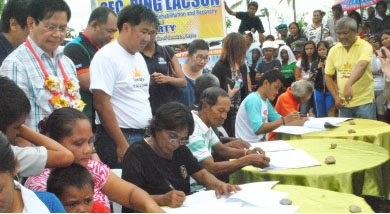 The climate is changing. We in Tacloban are living witnesses of the climate’s macabre leap.
The climate is changing. We in Tacloban are living witnesses of the climate’s macabre leap.
Scientists have attested that climate change is fueling stronger and more powerful typhoons classified as category five typhoons. These typhoons, seemed to have been made from hell, would normally ravage the Philippine typhoon ring every 50-60 years. But now, they are markedly doing an annual stopover. Pablo (2012) and Yolanda (2013), strengthen the postulate that this year, another monster might destroy another city. Mother Nature is providing us with obvious signs and patterns that we have to understand and deal with.
For a fact, we may not be able to wholly reverse the effects of climate change given the sustainable growth of urbanization, but, we can decelerate it. While doing this, we should also leap towards intensive mass education on disaster and calamity awareness. On an average citizen’s level, this is one of the most doable preventive measures. As a victim city of a great typhoon, I feel we should initialize and pioneer this.
By saying mass education, this means the inclusion of disaster and calamity awareness in school’s lessons. In grade school, the apt subject for this type of lesson would probably be Science. Classroom lectures and discussions on disaster causes and effects and courses of action during actual tragedy, are recommendable to allow the students understand and put to heart nature’s ruinous U-turn. This will also help the students value the rationale of cascaded procedures in case the actual calamity comes. Aside from the routine of classroom lectures, application should also be done through frequent and random drills facilitated by teachers and other school officials. Drills should allow students to execute the best actions and procedures during crisis. This will help students experience the feel of a calamity, so that come actual disaster time, they will react accordingly.
The DSWD and Pagasa should work hand-in-hand to train and educate the teachers as well. The two agencies should ensure that these teachers are fully equipped with knowledge to avoid critically erroneous teachings. This is also the best time to reactivate our dormant barangay officials. The government needs to tap them and oblige them to propagate preventive measures to their subordinates especially those who are illiterate and cannot afford schooling. I remembered, before the typhoon, that many barangay officials have poorly reacted towards warning reports of the media, resulting to the historic number of casualties.
This is no one-man effort. This will not work out without the cooperation of everyone. Let us stop blaming people already. I guess it is about time to stop dining on ashes and rubbing salt on our wounds. The best action now is to recover, understand and make use of the learning we acquired from the Yolanda experience. Let us please move on and brace ourselves for a rougher ride with nature. If we comply with the information we are spoon-fed with, the life that we save maybe our own.
What we need to teach
Cross
 For the whole Christian world, the coming of Jesus Christ is the greatest manifestation of God’s love for all of mankind. While many Christian sects do not follow the teachings of the Catholic Church on the Paschal mystery, many of such sects do some sort of observance of the Holy Week. The crucifixion of Jesus Christ was the strongest statement of His obedience to the will of the Father who sent Him so that man will be saved from the throes of sin.
For the whole Christian world, the coming of Jesus Christ is the greatest manifestation of God’s love for all of mankind. While many Christian sects do not follow the teachings of the Catholic Church on the Paschal mystery, many of such sects do some sort of observance of the Holy Week. The crucifixion of Jesus Christ was the strongest statement of His obedience to the will of the Father who sent Him so that man will be saved from the throes of sin.
People seem to have turned less observant of the practices that mark Holy Week as truly holy. Even in these holy days, we still find people having fun in their night escapades, enjoying in drinking sprees, hip-hopping in dance crazes and crooning their lungs out on videoke bars. Old folks would always share their stories about the reflective mood that people go through during the Lenten season and the Holy Week. The holy days would always be turned to somber mood in reflection of the passion and death of Jesus Christ.
It really is hard to understand how people could chose lackadaisically on unholy activities that go in conflict with the spirit of Holy Week. We cannot say that the Church had been lacking in reminders and admonitions to all and sundry regarding the proper conduct and behavior that will show reverence to these holy days. It is perhaps the lack of humility to accept God’s will that people tend to do their wants even if unpleasing and inappropriate for the Lenten season and the Holy Week.
But there is the light side amid these unholy practices that the faithful can turn to during the Holy Week. We still can find broadcast both on radio and television about biblical stories, narratives and movies that would remind us of the great love that Jesus Christ gave us. Apart from these movies and dramas, we can observe live reenactments in many places all over the country and the world, depicting the passion of Jesus Christ.
Above all, we can always take part in Eucharistic Celebrations in the many Catholic Churches where the passion and death of Jesus Christ is read, reflected on and prayed. Doing penance and sacrifices in atonement and for the forgiveness of our sins will make our holy days truly holy as we look inside our lives the Jesus Christ on the cross.
Comments to alellema@yahoo.com
20 families in Tanauan who lost homes during Yolanda relocated to their permanent homes


(LITO A. BAGUNAS)
TANAUAN, Leyte – Twenty families in this storm-stricken town are now in their permanent homes following the turnover of the first batch of housing units for Yolanda survivors last April 12, this year.
Presidential Assistant for Recovery and Rehabilitation Panfilo Lacson lauded the local government here and the Gawad Kalinga (GK) for their coordination in immediately building houses for survivors, who are either taking shelter in tents or temporary makeshift houses.
“The turnover ceremony will not be made possible without the indispensable participation of GK. With people like them, we are sure to rise from the rubble of destruction sooner than we can imagine,” Lacson said, addressing local officials and storm survivors in the new housing site in Pago village.
One of the first 20 homeowners, Arnie Penada, a 38-year-old fish vendor was moved to tears after receiving her new house with a floor area of 22 square meters (sqm). Each unit has a lot area of 36 sqm.
“Now, we can sleep well at night without worrying about big waves and strong winds every time there is a typhoon,” said Penada, whose old house in the so-called “no-build zone” in San Roque village was swept away by the giant waves generated by Yolanda on November 8,2013 .
The first 20 houses represent the first batch of the 366 housing units that will soon rise in Pago village, one the of three relocation sites identified by the local government.
“Our plan is to turnover houses to families in every two to three weeks,” said Tanauan Mayor Pelagio Tecson.
Each family is required to donate 1,500 hours of labor to fast track the construction phase. Recipients are obliged to complete the required working hours, even after the turnover of their houses.
About 500 residents are working on the site on a twice a week basis. The GK has deployed 500 volunteers to facilitate the rebuilding process.
This coastal town with a population of 53,310, is considered as pilot site for post-Yolanda rehabilitation and recovery among the 171 cities and municipalities in central Philippines pounded by the supertyphoon last year.
The permanent shelter for calamity victims is a joint project of the National Housing Authority, GK, Tanauan local government unit, and Department of Public Works and Highways.
Under the agreement, the NHA provided the funding for land development, prepared site engineering development plan, financed housing construction, and carry out survey works.
The local government unit assists GK in land acquisition, monitor project implementation, identify and screen project beneficiaries, and dispose housing units.
The DPWH is tasked to construct an access road to the housing site from the national highway and prepare engineering plans and cost estimates.
GK, on the other hand, has set aside a budget to acquire the land and donate it to the LGU for housing and counterpart budget for the construction of housing units. (SARWELL Q.MENIANO)
To house 500 families Tan, other key FFCCCII officials led ground-breaking of friendship village in Palo
PALO, Leyte-Some 500 families of this town whose houses were totally destroyed during the aftermath of supertyphoon Yolanda would soon have their homes courtesy of the members of the Federation of Filipino-Chinese Chambers of Commerce and Industry, Inc. (FFCCCII).
Last April 11, 2014, a simple ground-breaking ceremony for the development of the relocation site located at Barangay Barayong was held attended by key officials of the FFCCCII led by its chairman emeritus, Lucio Tan.
The housing project, dubbed as Filipino-Chinese Friendship Village, would be the home of about 500 families coming from different villages of Palo whose houses were totally destroyed by Yolanda.
Aside from constructing houses to the now homeless typhoon victims, the area would also be constructed with five- unit school buildings with two-classrooms each, said FFCCCII president Alfonso Siy.
Siy said that if their chairman emeritus Tan will like the outcome of the friendship village, he might add more units of houses. “Dr. Tan is few of the most generous people in the Philippines,” Siy said.
“Right now we are constructing 300 houses for the people affected by typhoon Sendong in Compostela Valley, Cagayan. After that, we will proceed with the construction of the houses here,” Siy added.
The construction of the houses will cost P40 million to P45 million while the school buildings with 10 classrooms will be at P2 million.
Some five hectares have been identified by the local government to host the project in Barayong, a mountainous village about two kilometers away from the town proper.
“We are thankful to the Filipino-Chinese community. The local government unit of Palo and the Department of Social Development and Welfare will screen those who will stay in the friendship village which will comprise families from the different villages badly hit by the typhoon. We will prioritize those who are still staying in tents as their temporary shelter,” Leyte Governor Leopoldo Dominic Petilla said.
The governor added that a new community will be created in Barayong, the villagers will be given livelihood program, a public market aside from the school.
“It is definitely be a village, within a village,” Energy Secretary Carlos Jericho Petilla said in his speech, as he promised that power supply would be provided immediately to the area.
Petilla, who was among the invited guests, enthused that the province of Leyte is very lucky with its partnership with the group of Tan.
“So far this is the biggest housing assistance given by a private group to typhoon Yolanda survivors in Palo. We presented our development plan for a new Palo to our guests during a simple program after the groundbreaking as they might be interested to invest here,” Petilla added.
According to FFCCCII secretary general Fernando Gan, the materials are pre-fabricated and there will be 5-houses in a row. Each unit will have 21-sqm. and one common comfort room.
Gan said the funding for the projects came from the different affiliated organizations led by the FFCCCII Foundation Inc., Federation of Filipino-Chinese Associations of the Philippines, World News Daily, Filipino-Chinese Amity Club, Overseas Chinese Alumni Association of the Philippines, Filipino-Chinese Shin Lian Association, and the Philippine Chinese Chamber of Commerce and Industry Inc.
Go Tic Ching, president of the Tacloban Filipino-Chinese Chamber of Commerce, Inc. (TFCCCI) and other officers graced the affair. (VICKY C.LANTING)
PCIC allocate P200 million crop insurance for Yolanda-hit farmers in Eastern Visayas
TACLOBAN CITY – The Philippine Crop Insurance Crop (PCIC) in the region is providing a P215 million premium subsidy to farmers affected by supertyphoon Yolanda.
PCIC president Jovy Bernabe said that the three provinces in Samar Island got P165 million from the P1 billion funding intended for poorest provinces. Leyte, Southern Leyte and Biliran provinces got P50 million subsidy.
The initiative shoulders full amount of the premium plus an accident insurance. In the past, the government only shoulders half of the premium cost.
“We are stepping our effort to reach the target of 70,000 farmers who will benefit this crop insurance program this year. Crop insurance is really important because it will protect us if natural calamities happen again,” Bernabe said during the launching of the premium subsidy scheme.
Usually, a farmer pays P890 for every P10, 000 worth of insurance coverage for both rice and corn. The state-owned crop insurance firm also offers 46 types of insurance packages for high value commercial crops.
The P50 million aid for Leyte, Southern Leyte and Biliran farmers and fishermen is part of the P80 million subsidy for Yolanda-affected areas not classified areas in the 20 poorest provinces.
The PCIC’s principal mandate is to provide insurance protection to farmers against losses arising from natural calamities, plant diseases and pest infestations of their rice and corn crops as well as other crops. The agency also provides protection against damage to non-crop agricultural assets. (SARWELL Q.MENIANO)
EV women leaders cited as “Glimmers of Hope”


THEY ARE not simply banner-flailers but are the “glimmers of hope,” from whom survivors of supertyphoon Yolanda have seen optimism and gathered their strength in rebuilding their lives, properties and livelihood after having been smashed to the ground by the enormously destructive disaster.
These women leaders who were cited by the Philippine Information Agency Regional (PIA-8) were not just heroes but epitome of the truly resilient and confident Filipino, the awards organizers believed.
For the significant role they respectively played in the relief, recovery and rehabilitation efforts in the Yolanda-stricken localities in the region, these “glimmers of hope” were formally conferred their distinction as such in a simple ceremony held on April 10 at the Leyte Sports Academy Conference Hall, Tacloban City.
PIA Regional Director Olive Tiu, who initiated the award though herself equally deserving of such distinction, underscored the individual undertaking of each of the awardees of “Glimmers of Hope” in their respective fields.
“The PIA has been working with both government and non-government organizations and international humanitarian agencies, thus PIA knows what is happening on the ground. It cannot remain blind to what it has observed and witnessed in the past five months since Yolanda. So we thought of this award to honor the women who have been working after Yolanda so that our people will remain strong and resilient,” she explained.
“If the international organizations and the government agencies are not there, we the people will lose hope and find it hard to rise and recover,” Tiu added.
Named as “Glimmers of Hope” were Samar Governor Sharee Ann Tan; Catbalogan City Mayor Stephanie Uy Tan whose LGU was the first to give relief respond to affected areas hours after the disaster; Palo Mayor Remedios Petilla; Health Assistant Regional Director Paula Paz Sydiongco and Social Welfare and Development Assistant Regional Director Virginia Idano.
Also cited were Tourism Regional Director Karina Tiopes, which agency conducted a cash-for-work for Tourism students in order for them to continue their schooling; Trade and Industry Regional Director Cynthia Nierras whose agency sent in series of caravan that offered commodities to the survivors at significantly lower price; Budget and Management-8 Director Imelda Laceras, whose agency responded with no delay for the soon release of funds to LGUs and other government agencies for their immediate disaster response operation.
Leyte II Electric Cooperative general manager Ma. Rosario Cumpio-Averstruz; Pauline Nayra of Runggiyan; Joyce Dorado-Alegre, professor of the University of the Philippines-Tacloban Campus who just ended her term as Commissioner of the National Commission in Culture and the Arts; Sandra Gani of UNFPA; Farida Casuyo of UNOCHA; Cristy Marfil of IOM in Ormoc City; as well as other female cluster heads of World Health Organization, International Federation of the Red Cross, UNCHR and UNICEF.
Aside from being first in the entire PIA nationwide, the regional office, through the initiative of Director Tiu, has piloted in Tanauan the designation of barangay information officers for more efficient communication link especially during these days following the assail of sty Yolanda. (EILEEN NAZARENO-BALLESTEROS)


